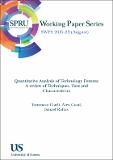Por favor, use este identificador para citar o enlazar a este item:
http://hdl.handle.net/10261/161556COMPARTIR / EXPORTAR:
 SHARE SHARE
 CORE
BASE CORE
BASE
|
|
| Visualizar otros formatos: MARC | Dublin Core | RDF | ORE | MODS | METS | DIDL | DATACITE | |

| Campo DC | Valor | Lengua/Idioma |
|---|---|---|
| dc.contributor.author | Ciarli, Tommaso | - |
| dc.contributor.author | Coad, Alex | - |
| dc.contributor.author | Rafols, Ismael | - |
| dc.date.accessioned | 2018-03-02T08:10:50Z | - |
| dc.date.available | 2018-03-02T08:10:50Z | - |
| dc.date.issued | 2016 | - |
| dc.identifier | doi: 10.1093/scipol/scv059 | - |
| dc.identifier | issn: 0302-3427 | - |
| dc.identifier | e-issn: 1471-5430 | - |
| dc.identifier.citation | Science and Public Policy 43(5): 630-645 (2016) | - |
| dc.identifier.uri | http://hdl.handle.net/10261/161556 | - |
| dc.description | El pdf corresponde con un Working Paper Series: SWPS 2015-23 (August); University of Sussex. | - |
| dc.description.abstract | A variety of quantitative techniques have been used in the past in future-oriented technology analysis (FTA). In recent years, increased computational power and data availability have led to the emergence of new techniques that are potentially useful for foresight and forecasting. As a result, there are now many techniques that might be used in FTA exercises. This paper reviews and qualifies quantitative methods for FTA in order to help users to make choices among alternative techniques, including new techniques that have not yet been integrated into the FTA literature and practice. We first provide a working definition of FTA and discuss its role, uses, and popularity over recent decades. Second, we select the most important quantitative FTA techniques, discuss their main contexts and uses, and classify them into groups with common characteristics, positioning them along key dimensions: descriptive/ prescriptive, extrapolative/normative, data gathering/inference, and forecasting/foresight. | - |
| dc.description.sponsorship | A first report form of this paper was prepared as part of the project financed by Nesta on ‘Research into the quantitative Analysis of Technology Futures’. We acknowledge further support from the US National Science Foundation (Award No. 1064146 ‘Revealing Innovation Pathways: Hybrid Science Maps for Technology Assessment and Foresight’) | - |
| dc.publisher | Oxford University Press | - |
| dc.relation.isversionof | Preprint | - |
| dc.rights | openAccess | - |
| dc.subject | Forecasting | - |
| dc.subject | Foresight | - |
| dc.subject | Future-oriented technology analysis | - |
| dc.subject | Quantitative techniques | - |
| dc.title | Quantitative analysis of technology futures: A review of techniques, uses and characteristics | - |
| dc.type | artículo | - |
| dc.identifier.doi | 10.1093/scipol/scv059 | - |
| dc.relation.publisherversion | https://doi.org/10.1093/scipol/scv059 | - |
| dc.date.updated | 2018-03-02T08:10:50Z | - |
| dc.description.version | Peer Reviewed | - |
| dc.language.rfc3066 | eng | - |
| dc.contributor.funder | National Science Foundation (US) | - |
| dc.contributor.funder | European Commission | - |
| dc.relation.csic | Sí | - |
| dc.identifier.funder | http://dx.doi.org/10.13039/100000001 | es_ES |
| dc.identifier.funder | http://dx.doi.org/10.13039/501100000780 | es_ES |
| dc.type.coar | http://purl.org/coar/resource_type/c_6501 | es_ES |
| item.fulltext | With Fulltext | - |
| item.openairecristype | http://purl.org/coar/resource_type/c_18cf | - |
| item.cerifentitytype | Publications | - |
| item.openairetype | artículo | - |
| item.grantfulltext | open | - |
| Aparece en las colecciones: | (INGENIO) Artículos | |
Ficheros en este ítem:
| Fichero | Descripción | Tamaño | Formato | |
|---|---|---|---|---|
| quanticaracte.pdf | 1,82 MB | Adobe PDF |  Visualizar/Abrir |
CORE Recommender
SCOPUSTM
Citations
8
checked on 18-abr-2024
WEB OF SCIENCETM
Citations
7
checked on 25-feb-2024
Page view(s)
258
checked on 22-abr-2024
Download(s)
352
checked on 22-abr-2024
Google ScholarTM
Check
Altmetric
Altmetric
NOTA: Los ítems de Digital.CSIC están protegidos por copyright, con todos los derechos reservados, a menos que se indique lo contrario.
